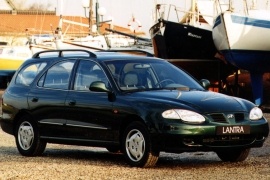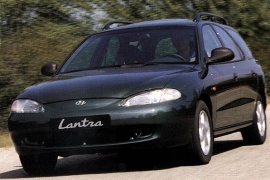HYUNDAI Lantra Wagon Models/Series Timeline, Specifications & Photos
First production year: 1995
Engines: Gasoline, Diesel
Body style: Wagon (station wagon, estate, combi, touring)
The Hyundai Lantra/Elantra Wagon was facelifted along with the rest of the range in 1998 as a 1999 model year.
Hyundai was already known on the market, and the station-wagon version was a thought-after version, especially as a family car. It couldn't miss from dealers' showrooms, so it was kept in production even after the third generation appeared on the market in 2000.
Hyundai realized that it needs a grille to cool the engine and installed one on the facelifted model. It left a thick vertical slat to host its chromed badge. To make the new front fascia more appealing, the carmaker changed the headlights and the bumper.
Inside, the carmaker kept the same flowing lines from the non-facelifted version, but depending on the trim level, it added some amenities such as the sunroof. Hyundai didn't want to sell its vehicles without a minimal package, but that was differently expressed according to the market where the car was sold. The only thing that didn't change was the high loading capacity, where the Lantra excelled. With its rear bench folded down completely, it could get up to 1755 liters (62 cu-ft).
Under the hood, depending on the market, the Lantra featured a wide choice of engines ranged between 1.5- and 2.0-liter gasoline units. The latter provided 139 hp, so the car was surprisingly quick. A diesel version was also on the offer, powered by a Peugeot-sourced engine paired to a five-speed manual.
The first generation of the Hyundai Lantra stayed on the market just five years, and it was replaced, in 1995, by a new generation.
Hyundai pushed the pedal to the metal to enhance its products and refreshed its products almost on a two-year basis. While other carmakers were facelifted their lineups every four years and changed generations every eight years, the Lantra went through a rapid development process.
In the mid-'90s, the wedged-shapes started to fade out, and the rounded design trend, also known as biodesign, started to speed-up and conquered most of the carmakers. The Korean designers didn't have the same experience as those from Europe or the U.S., but they tried as hard as they could to offer a nicely done vehicle. The Lantra Wagon was a good example. It featured ovoid-shaped headlights, which resembled those from the 1991 Honda Civic, and smooth, curved lines and panels. Apart from a narrow-angle on the upper side of the rear side windows, there was no angle on the car. Everything was curved. Even the tailgate's window featured curved corners. Worth mentioning that it was the first station-wagon built by Hyundai.
The interior featured a simple design with more curved lines. Even the vents were curved and followed the exterior's biodesign trend. It offered decent room for four adults, with good headroom for the rear passengers. As for the legroom, that was depending on the front passengers' height. Its rear bench split-folding seatback was good to expand the otherwise minimal trunk space.
The Lantra J2 featured fully independent suspension, which led to a higher level of comfort and better cornering speeds. But it wasn't a sporty vehicle. Hyundai developed the 1.6-liter engine and replaced the older Mitsubishi units used on the Lantra J1.

